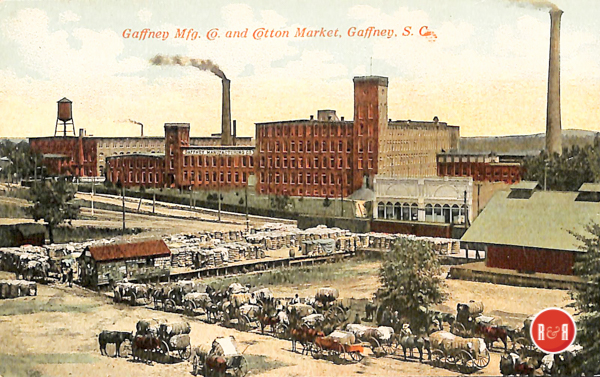City Directories and History: The Gaffney Depot and its link to the railroad and textile mills was an integral part of the economic viability of the region.
The Yorkville Enquirer of June 5, 1873 taken from the Spartanburg Sparen – “Gaffney’s near Limestone Springs, is destined to be a village of considerable trade and importance. The trains now stop there for dinner both going and coming from Charlotte and though there is yet no hotel, Dr. Gaffney serves up a very good dinner for passengers and railroad officials.”
The Yorkville Enquirer reported on July 22, 1880 with an update on Gaffney City – “Our town has a population of 400 and has eleven dry goods and general mercantile stores, one drug store, one hardware and grocery store, one grocery and supply house and one saloon. The churches include: Baptist, Pres., Methodist, and an Episcopal Chapel in the process of erection. There are several lodges. The Gaffney City Hotel with landlord, Mr. R.W. Hamilton is a landmark.”
The Yorkville Enquirer reported on May 25, 1882 – “Citizens of Gaffney City the area met at Wood’s Hall to discuss the new county movement. Mr. W. Waddy Thomson was elected Chairman.”
The Rock Hill Herald reported on Jan. 11, 1883 making a progress report on Gaffney: “There are four churches which are Baptist, Methodist, Presbyterian and Episcopalian. There are two schools, the Cooper Limestone Institute and the Gaffney City High School. Businesses include: 24 business houses, three cotton gins, a shingle maker, a planning mill, two meat markets, two livery and sales stables, and a first class bakery.” Earlier on Jan. 4, 1883 the YK Enquirer reported that the “Gaffney City Town Council recently purchased 10.5 acres for a city cemetery. Furthermore, Capt. S.S. Ross operates a branch bank and brokers office and Col. Wm. W. Gaffney operates a real estate agency.”
The Herald on Sept. 8, 1887 reported – “Carroll and Stacey of Gaffney City have opened a cotton office in Rock Hill, represented here by Mr. E.B. Biggers. This firm is one of the largest in upper S.C., Mr. R.L. Sturgis is the bookkeeper.”
The Yorkville Enquirer reporting from the Gaffney City Ledger on April 23, 1898 that the OR&C Railroad Company has bought the property of Mr. B.F. Holmes opposite the depot on Frederick Street.
Fueling stations for the locomotives were a necessity and each required a designating name in order that fuel and other materials vital to the operation of the system could be dispatched to that location. The names of the stations were usually derived from a family prominent in the area, some notable landmark, or a historical site nearby. In 1804 a young man from Granard, County Longford, Ireland, Michael Gaffney established his home and combination store and tavern at the junction of the Virginia-Georgia road, which approximated present day Highway 29, and the Mills Gap road. Michael died in 1854 leaving substantial holdings, a large family, and his wife Mary “Polly” Smith Gaffney who lived to see the arrival of the Iron Horse in 1872. Before the Revolutionary War until the coming of that marvel of transportation, the social, cultural, and religious life of the immediate area centered around the Limestone Springs settlement which

Postcard view of the Gaffney Depot. Courtesy of the AFLLC Collection – 2017
consisted of a large hotel, later to become Limestone College, several businesses, a post office and many fine homes, one of which was the summer home of Governor David Johnson, all situated about one and one half miles from Gaffney’s Cross Roads. Prior to the formation of the county a large area of northeastern Spartanburg County formed a township known as Limestone Springs which included the famous resort. Thus happenings of some distance away are sometimes erroneously construed to have occurred in the immediate area of the resort. With the coming of the railway, businesses and those erecting new homes tended to move toward the new center of transportation. Sensing this inclination, the Gaffney family had lots, streets, and alleys surveyed and a small city laid out on the plan of Philadelphia with streets running parallel to each other and each block containing two alleys that intersected at the center of each block. On September 7, 1873, an auction of the lots was conducted and the formation of Gaffney City, as it was first called, was on its way.
(Information from: Names in South Carolina by C.H. Neuffer, Published by the S.C. Dept. of English, USC)
Stay Connected
Explore history, houses, and stories across S.C. Your membership provides you with updates on regional topics, information on historic research, preservation, and monthly feature articles. But remember R&R wants to hear from you and assist in preserving your own family genealogy and memorabilia.
Visit the Southern Queries – Forum to receive assistance in answering questions, discuss genealogy, and enjoy exploring preservation topics with other members. Also listed are several history and genealogical researchers for hire.
User comments welcome — post at the bottom of this page.
Please enjoy this structure and all those listed in Roots and Recall. But remember each is private property. So view them from a distance or from a public area such as the sidewalk or public road.
Do you have information to share and preserve? Family, school, church, or other older photos and stories are welcome. Send them digitally through the “Share Your Story” link, so they too might be posted on Roots and Recall.
Thanks!



